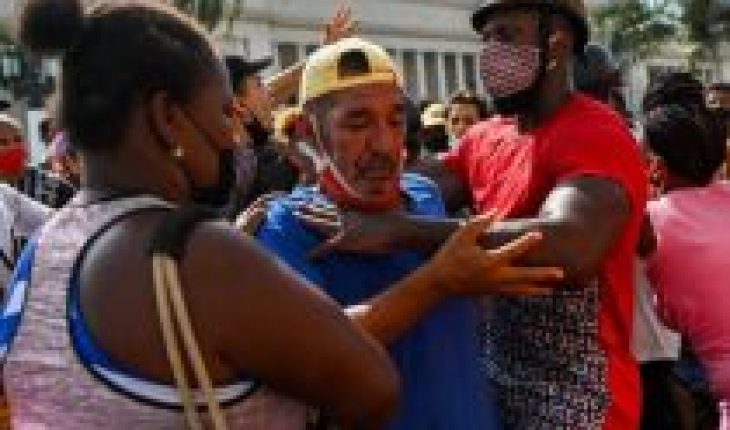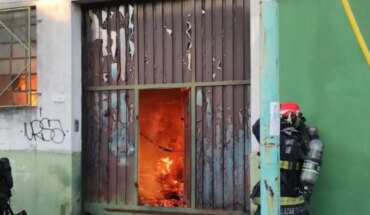
“The internet is still cut off, I don’t know where many of my friends are,” says one of the protesters who recorded and shared videos of the protests in Cuba.
On Tuesday, the partial restriction of service and the selective blocking of social networks that has hindered the flow of information on the island continues, following the historic protests on Sunday where demonstrators broadcast “live” what was happening in different parts of the country.
This is how the government of Miguel Díaz-Canel responded to the so-called “digital revolution” of the opponents that, since the massification of internet access among Cubans a little more than two years ago, has generated alternative information channels to the official media.
And that Sunday, July 11, opened a new chapter in the recent history of the island.
It began in San Antonio de los Baños and spread like a wave through the rest of Cuba.
It was there, in a city 26 kilometers from Havana, where on Sunday, at about 11 a.m., began the first live broadcasts of people protesting in the streets through Facebook Live, something known to Cubans as “the direct”.
Opponents of the government prefer “the direct” because, unlike videos recorded and posted on other platforms, it cannot be deleted.
This was how live broadcasts in San Antonio lit the fire in other cities that were added to the demonstrations, until the internet stopped working in several parts of the country.
“That it was like a domino effect. We saw a spontaneous protest in San Antonio and that spread,” says activist Alfredo Martínez Ramírez from Havana, who recorded videos of the demonstrations in Havana.
“It’s not the same to see that the people threw themselves into the street to be told. That gives courage,” he says in a conversation with BBC Mundo.
The protests began in the city of San Antonio de los Baños, southwest of Havana, and spread across the country. IMAGE SOURCE: GETTY IMAGES
Martinez says he participated in several protests where he recorded videos of protesters and police violence and shared them on social media. “I was outside the Capitol and posted the videos on Facebook.”
(You can see the recorded videos by Alfredo Martínezin this link. The BBC is not responsible for content posted by other websites or social networks).
Like him, other protesters spread videos on networks that went around the world.
President Miguel Diaz-Canel said Monday that the protests sought to “fracture the unity” of the Cuban people and discredit “the work of the government and the revolution.”
“There is a sector that commits crimes. Yesterday we saw criminals. Yesterday the proposal was not peaceful, there was vandalism (…) they stoned police forces, they turned cars. Totally vulgar, indecent, delinquent behaviour,” he insisted.
“We don’t call on the people to confront the people. we we called on the people to defend the revolution, to defend their rights. And the people supported.”
Pro-government demonstrations were also spread on social media.
BBC Mundo requested an interview with the government, but so far has not received a response.
“Social media was the trigger”
“The internet was a facilitator of the protests because it allowed people to share images in real time on Facebook Live,” says Ted Henken, author of the book, from New York. Cuba’s Digital REvolution (“Cuba’s Digital Revolution”), published in June.
“That’s why it could spread so quickly across the country. Social media was the trigger that channeled social frustration,” he tells BBC Mundo.
According to Henken, it has been very important for people to be able to do “the direct” because it does not give the government the ability to force people to remove the content they have posted.
“Those videos shared on Facebook Live were recorded by the protesters themselves, not by personalities,” he adds.
However, contributing to the multiplier effect is the fact that other media, independent journalists, influencers, artists, spread them.
This was how the labels #SOSCuba or #SOSMatanzas that were circling a few days ago on social networks quickly became more crowded, joining others already known as #PatriaYVida.
In addition to Facebook, which is the most important network on the island, Cubans use Whatsapp, Signal and Telegram, dubbed by Henken as “The Three Musketeers”, and to a lesser extent, Twitter and Instagram.
However, warns the author, it is important “not to err on the look of optimism”, because although internet access has changed the game in Cuba, you can’t know who’s going to win.
“The Internet has been like a kind of perestroika”
December 2018 is considered an emblematic date in Cuba: it is the time when people had access to the internet in a most massive way through their cell phones.
That’s why many say that moment marked a before and after in the island’s recent history.
“The Internet has been like a kind of perestroika in the Cuban context,” says Norges Rodríguez, director of the opposition media outlet online Yucabyte. Another milestone that has marked the role of social media in Cuban protests occurred in November 2020, when members of the San Isidro Movement made “direct” of their hunger strike.
And then, when they were evicted by the police, supporters made a protest that was also broadcast live on the networks.
“It’s a cumulative effect,” Rodriguez says.
Analysts agree that internet access, along with the deteriorating economic situation and the havoc caused by the covid-19 pandemic, are some of the factors that converged for opponents to take to the streets.
“Food, medicine, vaccines, freedom, are the common demands. They’re the same frustrations, but now they have the same technology,” explains Ted Henken.
With the massification of the internet, in the last two years the country has been the scene of demonstrations that have gained strength through social networks.
In 2019 there were campaigns online against the Constitutional Referendum and calls for marches through networks for the rights of LGBT people, memes critical of the government and the youtubers with dissenting speech they became more popular.
Thus, a movement that claims the need for change in the country through networks gained traction, a phenomenon that, without these platforms, would have been more difficult, says Henken.
The Internet: a weapon for both sides
It has been more than two years since the use of the Internet in Cuba became more common.
His influence has reached such a magnitude that he is a key player among the opponents, but also for the government.
Police and plainclothes officers repressed protesters. IMAGE SOURCE: GETTY IMAGES
Just as on Sunday morning – and for several hours – people were able to do “the direct” without major difficulties by showing what was happening in the protests in different parts of the country, the government also reacted.
It was at about 4 pm that the Cuban government began cutting off the internet. No more Facebook Live and the lack of information sowed bewilderment.
Cutting the nets is, in one way or another, like cutting off oxygen to the protesters.
A “Blackout digital” that has been extended until this Tuesday and that can be extended for as long as the government deems necessary.
“Almost all my friends are without internet,” says Alfredo Martínez Ramírez.
“And there are many that we don’t know where they are,” he adds.
A digital confrontation that has become a key weapon for both sides.
“Who is going to control the Cuban digital revolution?… no one and everyone, because there is no clear winner. This is a battle,” warns Ted Henken.





